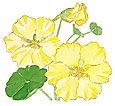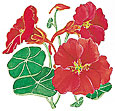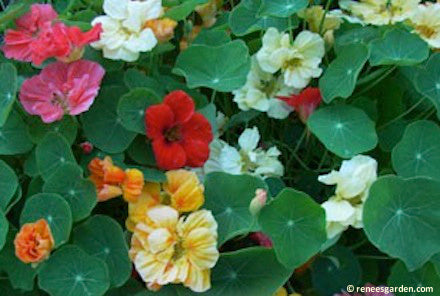
Easy, Colorful Edible Nasturtiums
|
A Little BackgroundNasturtiums were commonly known in Europe as Indian Cress or a translation of “Capucine cress,” in reference to the flower shape, which resembles Capucine monks’ hooded robes. Leaves of both species were eaten in salads; unripe seeds and flower buds were pickled and served as a substitute for capers. (We know now that these pickled flower buds are high in oxalic acid and therefore should not be eaten in large quantities.) Their ornamental value was also appreciated: flowers were used in nosegays, and planted to adorn trellises or cascade down stone walls. They became especially popular after being displayed in the palace flowerbeds of French king Louis XIV. |
To view all
To view and purchase
|
Although it is sometimes reported that nasturtiums were introduced to the US by the Philadelphia seedsman Bernard McMahon in 1806, they were recorded here as early as 1759. Thomas Jefferson planted them in his vegetable garden at Monticello from at least 1774 onward. Interestingly, in one entry in his garden book, he categorized it as a fruit amongst others such as the tomato, indicating that he ate the pickled seeds. Most nasturtiums grown at this time were the tall, trailing orange variety. Over the course of the 19th century, breeders produced smaller, more compact types that mounded neatly into containers or formed a colorful, less sprawling edge to flower beds. Cultivars with cream and green variegated foliage appeared, as well as the vermilion-flowered Empress of India, with its strikingly contrasting blue-green leaves. These developments paralleled the gradual shift in the perception of nasturtiums from edible and herbal garden mainstays to viewing them as ornamental landscape plants. Monet let large swaths ramble along a walk at Giverny. The flowers and long-lasting leaves were popular in Victorian bouquets and table arrangements. Nasturtiums were still eaten, however, and were known to help prevent scurvy, since the leaves are rich in Vitamin C.
Later 20th century contributions to nasturtium breeding include the introduction of varieties with spurless, upward-facing blossoms and flowers that float higher above the leaves, perfect for bedding or containers. A full spectrum of flower colors is now available, including single colors — useful for landscape designs: pale yellow, golden, orange, brick-red, cherry pink, salmon, crimson, and dark mahogany. The recent interest in edible flowers, herbs, ornamental kitchen gardens and heirloom flowers has helped keep a full array of old and new cultivars available for every possible use. Here are my top favorites:

Whirlybird: When I plant flowers in my mostly green vegetable garden, I like a cheerful mix of rainbow colors. Whirlybird comes in some of the most interesting shades like cherry pink and mahogany among the usual red, orange and yellow — and it’s easier to clean any stray bugs out of the spurless blossoms! Whirlybirds also produce more flowers than some of the trailing types in richer soil, and their compact habit allows the vegetables enough space.
Moonlight, with its buttery yellow blossoms, is ideal for those who prefer a more subtle color palette. It’s my favorite vining variety for growing up a trellis; one year, some pale blue morning glories intertwined through the pale yellow flowers and the effect was dreamy.
Empress of India: A collector’s heirloom with unusual blue-green leaves and long-spurred, deep red flowers, Empress of India is beautiful underneath tall summer-flowering bulbs or dahlias. It also matches darker leaved vegetables such as kale or broccoli. Plant it in children’s gardens to attract hummingbirds!
Growing Nasturtiums
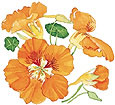 Nasturtiums are easy to grow, although the saying “Be nasty to nasturtiums” is somewhat harsh: choose a well-drained site with soil that is not too rich in nitrogen (since too much nitrogen results in lots of foliage, but fewer blooms). I like to add compost in very sandy soil, though, to help hold moisture. In areas with cool summers, nasturtiums grow well in full sun, but in hot summer areas, afternoon shade and plenty of moisture give best results. Press the large seeds directly into the ground after no more frost is expected and the soil is warmed up. In short-season areas, you can start seeds indoors, but this usually isn’t worth the effort, since plants grow and flower quickly once the weather turns warm. If you grow trailing varieties on a trellis, help train and tie them up as needed, since they don’t produce clinging tendrils.
Nasturtiums are easy to grow, although the saying “Be nasty to nasturtiums” is somewhat harsh: choose a well-drained site with soil that is not too rich in nitrogen (since too much nitrogen results in lots of foliage, but fewer blooms). I like to add compost in very sandy soil, though, to help hold moisture. In areas with cool summers, nasturtiums grow well in full sun, but in hot summer areas, afternoon shade and plenty of moisture give best results. Press the large seeds directly into the ground after no more frost is expected and the soil is warmed up. In short-season areas, you can start seeds indoors, but this usually isn’t worth the effort, since plants grow and flower quickly once the weather turns warm. If you grow trailing varieties on a trellis, help train and tie them up as needed, since they don’t produce clinging tendrils.
Much folklore exists involving nasturtiums’ supposed ability to repel pests due to their peppery taste and pungent scent. In my garden, however, slugs enjoy hiding beneath the shade of their broad leaves (you can collect them there!) and aphids adore them. For this reason, organic gardeners often sow them at the base of fruit trees as a trap crop. My neighbor, Dave, plants nasturtiums every season, swearing that they keep pests off his tomato vines. Given the wealth of contradictory information, I’ve concluded that planting nasturtiums will probably not significantly affect the pest populations on your other crops!
Eating Nasturtiums
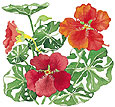 For tastiest nasturtium leaves, keep the plants well watered, which helps to moderate the spiciness of the leaves and flowers. I prefer to toss them among sweeter greens like butterhead or crunchy Batavian lettuce, rather than with other bitter greens. They add a refreshing bite to a classic potato salad with hard-boiled eggs and a mayonnaise dressing, and pair well with seafood. A handful of the bright colored flower petals are delicious chopped into a shrimp or crab salad sandwich filling, and the whole flowers and leaves make a great garnish for a platter of grilled salmon.
For tastiest nasturtium leaves, keep the plants well watered, which helps to moderate the spiciness of the leaves and flowers. I prefer to toss them among sweeter greens like butterhead or crunchy Batavian lettuce, rather than with other bitter greens. They add a refreshing bite to a classic potato salad with hard-boiled eggs and a mayonnaise dressing, and pair well with seafood. A handful of the bright colored flower petals are delicious chopped into a shrimp or crab salad sandwich filling, and the whole flowers and leaves make a great garnish for a platter of grilled salmon.
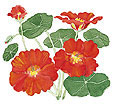
After picking nasturtium flowers for eating, make sure to double check that you’ve washed out any insects that might be hiding within the spurs! I prefer breaking the petals into salads rather than using them whole to keep the flavor less overwhelming, but whole flowers make beautiful and festive decorations. Another of my favorite uses of nasturtium flowers (from the inspiring book Garden Crafts for Kids, by Diane Rhoades) is as decorations atop frosted birthday cupcakes. Children are invariably delighted that the flowers are edible, too! Press the flowers on just before serving so that they look freshest and most enticing. For grownup parties, use the petals to decorate any savory open-faced sandwiches.
However you use them, spicy-sweet nasturtium flowers are a wonderful way to introduce edible flowers from the garden to both children and uninitiated adults.
|
A Little BackgroundNasturtiums were commonly known in Europe as Indian Cress or a translation of “Capucine cress,” in reference to the flower shape, which resembles Capucine monks’ hooded robes. Leaves of both species were eaten in salads; unripe seeds and flower buds were pickled and served as a substitute for capers. (We know now that these pickled flower buds are high in oxalic acid and therefore should not be eaten in large quantities.) Their ornamental value was also appreciated: flowers were used in nosegays, and planted to adorn trellises or cascade down stone walls. They became especially popular after being displayed in the palace flowerbeds of French king Louis XIV. |
To view all
To view and purchase
|
Although it is sometimes reported that nasturtiums were introduced to the US by the Philadelphia seedsman Bernard McMahon in 1806, they were recorded here as early as 1759. Thomas Jefferson planted them in his vegetable garden at Monticello from at least 1774 onward. Interestingly, in one entry in his garden book, he categorized it as a fruit amongst others such as the tomato, indicating that he ate the pickled seeds. Most nasturtiums grown at this time were the tall, trailing orange variety. Over the course of the 19th century, breeders produced smaller, more compact types that mounded neatly into containers or formed a colorful, less sprawling edge to flower beds. Cultivars with cream and green variegated foliage appeared, as well as the vermilion-flowered Empress of India, with its strikingly contrasting blue-green leaves. These developments paralleled the gradual shift in the perception of nasturtiums from edible and herbal garden mainstays to viewing them as ornamental landscape plants. Monet let large swaths ramble along a walk at Giverny. The flowers and long-lasting leaves were popular in Victorian bouquets and table arrangements. Nasturtiums were still eaten, however, and were known to help prevent scurvy, since the leaves are rich in Vitamin C.
Later 20th century contributions to nasturtium breeding include the introduction of varieties with spurless, upward-facing blossoms and flowers that float higher above the leaves, perfect for bedding or containers. A full spectrum of flower colors is now available, including single colors — useful for landscape designs: pale yellow, golden, orange, brick-red, cherry pink, salmon, crimson, and dark mahogany. The recent interest in edible flowers, herbs, ornamental kitchen gardens and heirloom flowers has helped keep a full array of old and new cultivars available for every possible use. Here are my top favorites:

Whirlybird: When I plant flowers in my mostly green vegetable garden, I like a cheerful mix of rainbow colors. Whirlybird comes in some of the most interesting shades like cherry pink and mahogany among the usual red, orange and yellow — and it’s easier to clean any stray bugs out of the spurless blossoms! Whirlybirds also produce more flowers than some of the trailing types in richer soil, and their compact habit allows the vegetables enough space.
Moonlight, with its buttery yellow blossoms, is ideal for those who prefer a more subtle color palette. It’s my favorite vining variety for growing up a trellis; one year, some pale blue morning glories intertwined through the pale yellow flowers and the effect was dreamy.
Empress of India: A collector’s heirloom with unusual blue-green leaves and long-spurred, deep red flowers, Empress of India is beautiful underneath tall summer-flowering bulbs or dahlias. It also matches darker leaved vegetables such as kale or broccoli. Plant it in children’s gardens to attract hummingbirds!
Growing Nasturtiums
 Nasturtiums are easy to grow, although the saying “Be nasty to nasturtiums” is somewhat harsh: choose a well-drained site with soil that is not too rich in nitrogen (since too much nitrogen results in lots of foliage, but fewer blooms). I like to add compost in very sandy soil, though, to help hold moisture. In areas with cool summers, nasturtiums grow well in full sun, but in hot summer areas, afternoon shade and plenty of moisture give best results. Press the large seeds directly into the ground after no more frost is expected and the soil is warmed up. In short-season areas, you can start seeds indoors, but this usually isn’t worth the effort, since plants grow and flower quickly once the weather turns warm. If you grow trailing varieties on a trellis, help train and tie them up as needed, since they don’t produce clinging tendrils.
Nasturtiums are easy to grow, although the saying “Be nasty to nasturtiums” is somewhat harsh: choose a well-drained site with soil that is not too rich in nitrogen (since too much nitrogen results in lots of foliage, but fewer blooms). I like to add compost in very sandy soil, though, to help hold moisture. In areas with cool summers, nasturtiums grow well in full sun, but in hot summer areas, afternoon shade and plenty of moisture give best results. Press the large seeds directly into the ground after no more frost is expected and the soil is warmed up. In short-season areas, you can start seeds indoors, but this usually isn’t worth the effort, since plants grow and flower quickly once the weather turns warm. If you grow trailing varieties on a trellis, help train and tie them up as needed, since they don’t produce clinging tendrils.
Much folklore exists involving nasturtiums’ supposed ability to repel pests due to their peppery taste and pungent scent. In my garden, however, slugs enjoy hiding beneath the shade of their broad leaves (you can collect them there!) and aphids adore them. For this reason, organic gardeners often sow them at the base of fruit trees as a trap crop. My neighbor, Dave, plants nasturtiums every season, swearing that they keep pests off his tomato vines. Given the wealth of contradictory information, I’ve concluded that planting nasturtiums will probably not significantly affect the pest populations on your other crops!
Eating Nasturtiums
 For tastiest nasturtium leaves, keep the plants well watered, which helps to moderate the spiciness of the leaves and flowers. I prefer to toss them among sweeter greens like butterhead or crunchy Batavian lettuce, rather than with other bitter greens. They add a refreshing bite to a classic potato salad with hard-boiled eggs and a mayonnaise dressing, and pair well with seafood. A handful of the bright colored flower petals are delicious chopped into a shrimp or crab salad sandwich filling, and the whole flowers and leaves make a great garnish for a platter of grilled salmon.
For tastiest nasturtium leaves, keep the plants well watered, which helps to moderate the spiciness of the leaves and flowers. I prefer to toss them among sweeter greens like butterhead or crunchy Batavian lettuce, rather than with other bitter greens. They add a refreshing bite to a classic potato salad with hard-boiled eggs and a mayonnaise dressing, and pair well with seafood. A handful of the bright colored flower petals are delicious chopped into a shrimp or crab salad sandwich filling, and the whole flowers and leaves make a great garnish for a platter of grilled salmon.

After picking nasturtium flowers for eating, make sure to double check that you’ve washed out any insects that might be hiding within the spurs! I prefer breaking the petals into salads rather than using them whole to keep the flavor less overwhelming, but whole flowers make beautiful and festive decorations. Another of my favorite uses of nasturtium flowers (from the inspiring book Garden Crafts for Kids, by Diane Rhoades) is as decorations atop frosted birthday cupcakes. Children are invariably delighted that the flowers are edible, too! Press the flowers on just before serving so that they look freshest and most enticing. For grownup parties, use the petals to decorate any savory open-faced sandwiches.
However you use them, spicy-sweet nasturtium flowers are a wonderful way to introduce edible flowers from the garden to both children and uninitiated adults.




